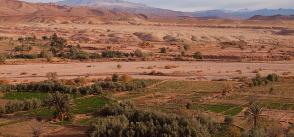
Climate change, gender, decision-making power, and migration into the Saiss region of Morocco
Studies on migration in the Middle East and North Africa region have so far focused on migration to urban areas (local cities and European countries). Little research has explored internal migration into rural areas.
Yet in Morocco rural-rural migration is an important strategy for many who are escaping climate variability and unemployment in their hometowns to take advantage of labor opportunities in thriving agricultural enterprises.
Gender remains largely missing from migration research in Morocco especially for migrant women. Gender differences are important to account for as men and women have diverse motives, strategies and experiences with migration, and thus require different interventions. In light of gender differences and climate-induced migration and investments in irrigation, this research follows up on the ground to understand the experiences of men and women laborer as the migration continues in three rural areas in the Saiss region (Morocco). These are chosen based on differences in socio-economic, gender norms, and biophysical dynamics to capture as diverse experiences as possible with labor work and migration as possible. These areas also represent both sending and receiving communities.
Data was collected through a survey administered to 400 laborers (179 women and 221 men) employed in the intensified agricultural sector of Saiss in Morocco.
Read the full article and download the working paper via FAO Family Farming Knowledge Platform.
[Photo by Evgeni Zotov | Flickr]







